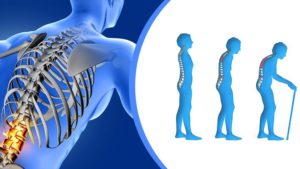 Osteoporosis is characterized by a loss of bone mass throughout the skeleton which greatly increases risk of fracture. Fractures, particularly in the elderly, can lead to hospitalization and immobility. This can further lead to respiratory or other infections, which can be fatal. According to the Center for Disease Control, osteoporosis is more common in women than in men. It affects about 25% (1 in 4) of women age 65 and over, and about 5% (1 in 20) of men age 65 and over.
Osteoporosis is characterized by a loss of bone mass throughout the skeleton which greatly increases risk of fracture. Fractures, particularly in the elderly, can lead to hospitalization and immobility. This can further lead to respiratory or other infections, which can be fatal. According to the Center for Disease Control, osteoporosis is more common in women than in men. It affects about 25% (1 in 4) of women age 65 and over, and about 5% (1 in 20) of men age 65 and over.
Bone Density & Osteoporosis
Osteoporosis literally means “porous bone.” Healthy bone has a honeycomb-like appearance. In osteoporosis, the holes and spaces in the honeycomb are much larger than in healthy bone, making it fragile and weak. Healthy bone continually remodels itself through a process of absorbing and replacing bone tissue. In osteoporosis, bone tissue is lost faster than it can be replaced (this is believed to begin occurring as early as age 35). This leads to the bone becoming less dense, porous, weaker, and more prone to fracture. Because there are often no symptoms, a broken bone is usually the event that leads to a diagnosis of osteoporosis. This is why early detection through screening is so important. Age-related bone loss in both men and women that predisposes them to fracture is known as type II osteoporosis. Osteoporosis in women related to menopause is known as type I.
Causes & Risk Factors
Factors that are known to cause or contribute to, osteoporosis include:
- Gender – Females are at greater risk.
- Ethnicity – Caucasians and Asians have proven to be at greater risk.
- Age – Risk is increased for those age 50 and over and continues to increase with age.
- Family history of osteoporosis
- Having a thin, small-framed body
- Low calcium intake
- A sedentary lifestyle
- Early menopause (before age 45)
- Females who have not had children.
- Smoking
- Certain long-term medication use.
- Certain endocrine diseases (especially hyperthyroidism & hyperparathyroidism)
- Excessive intake of alcohol or caffeine
- Diet – high protein and/or high phosphate intake Signs & Symptoms
As mentioned above, there are often no signs/symptoms associated with osteoporosis as bone loss can progress for many years and remain undetected until a fracture occurs. Detectable signs could include skeletal deformity. Especially a curving of the upper spine known as kyphosis, and/or loss of height. Unexplained spinal pain or a broken bone can also be an indication of osteoporosis.
Your Screening & What to Expect
The good news is that your osteoporosis screening is non-invasive and painless. Known as a bone density test, it is conducted using ultrasound over an especially dense section of bone, usually the shinbone (tibia). This test can determine not only bone density but also bone quality. Speed of sound (SOS) and broadband ultrasound attenuation (BUA) are the ultrasound properties used to assess bone strength and fragility. Your test results will be sent to you, and you are encouraged to share them with your primary care physician.
If your test result is positive for osteoporosis, you can expect your physician to make some of the following recommendations:
- Medications may be prescribed.
- Hormone replacement therapy (estrogen for women/testosterone for men) may be prescribed.
- You will be encouraged to quit smoking and drinking alcohol.
- You will be encouraged to take measures to reduce the risk of falls (like wearing appropriate footwear and modifying your home environment).
- You will be encouraged to maintain a diet rich in calcium, vitamin D, and other nutrients that are important for bone health.
- You will be encouraged to exercise (muscle strengthening & weight-bearing while avoiding high impact).
- If you are 50 years of age or over, are 40 years of age or over with risk factors, or possess any of the above-mentioned risk factors, please get screened for osteoporosis as soon as possible.
